Class 3 Maths Chapter 7 Solutions Question Answer Raksha Bandhan
Raksha Bandhan Class 3 Maths Question Answer
Raksha Bandhan Class 3 Solutions
NCERT Textbook Page 82
Question 1.
What do you find interesting here?
Answer:
Do it yourself.
Question 2.
Find and count the number of each of these objects and write.

Answer:

![]()
Let’s make Rakhis (NCERT Textbook Pages 83-84)
Question 1.


Answer:


Try it Out! (NCERT Textbook Page 85)
For making 10 such Rakhis, we need __________ flowers, __________ threads and __________ beads. There are 30 flowers, 30 threads and 30 beads. How many Rakhis can you make with this material? Use drawings if needed to find out the answer.

Answer:
For making 10 such Rakhis, we need 10 flowers, 20 threads and 40 beads.
There are 30 flowers, 30 threads and 30 beads. How many Rakhis can you make with this material?
For each Rakhi we need one flower, two threads and four beads.
So, we can make 7 Rakhis from 30 flowers, 30 threads and 30 beads.
Jagannath Sweet Shop (NCERT Textbook Page 86)

Answer:
How would we count the laddoos in this box?

3 + 3 + 3 = 9
or, three times three equals 9
or, 3 × 3 = 9
There are 9 laddoos in this box.

3 + 3 + 3 + 3 + 3 + 3 = 18
Or, 6 times 3 equals 18.
Or, 6 × 3 = 18.
There are 18 laddoos.
![]()
NCERT Textbook Page 87
Question 1.

Can you help Dhara find this out?
Imagine yourself to be Dhara. Distribute 18 laddoos equally among nine of your friends.
Let’s see how Dhara has done it.

When 18 laddoos are shared equally among nine people, each of them gets __________ laddoos.
18 equally shared by 9 is 2 each.
Or, 18 ÷ 9 = 2 laddoos.
Answer:
Let’s see how Dhara has done it.
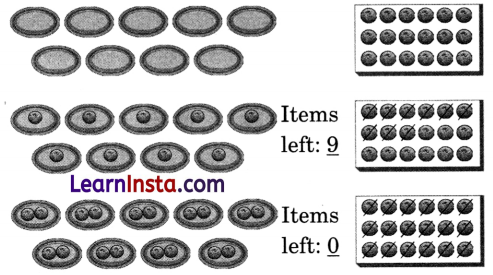
When 18 laddoos are shared equally among nine people, each of them gets 2 laddoos.
18 equally shared by 9 is 2 each.
Or, 18 ÷ 9 = 2 laddoos.
Try it Out! (NCERT Textbook Page 88)
Look at the figure carefully. Estimate the number of kaju katlis.
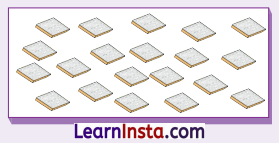
Count and write the number of kaju katlis.
Total number of kaju katlis = __________
Answer:
Total number of kaju katlis = 20
Let us Do (NCERT Textbook Pages 90-91)
Question 1.
Distribute all the kaju katlis equally among 4 people. How many kaju katlis will each get?

Let us do this in the picture given below. Strike out the kaju katlis from the tray and draw them in the plates. The first step has been done for you.

Each will get __________ kaju katlis.
16 ÷ 4 = __________
Answer:
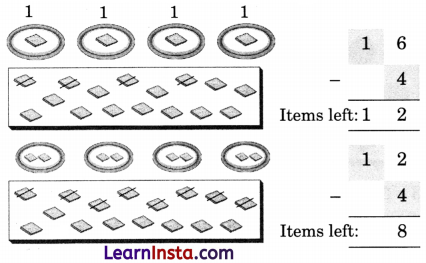

Each will get four kaju katlis.
16 ÷ 4 = 4
![]()
Question 2.
Distribute all the 15 pedas in plates equally among 5 people. How many pedas will each get?

15 equally shared by 5 is __________ each.
15 ÷ 5 = __________
Answer:
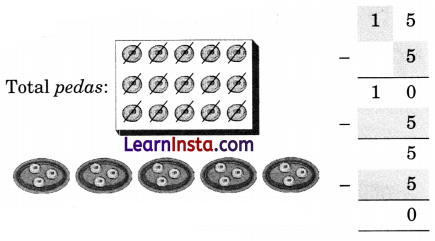
15 equally shared by 5 is 3 each.
15 ÷ 5 = 3
Let us Think (NCERT Textbook Pages 91-92)
Question 1.
Each cycle needs 2 wheels. How many cycles can be fitted with 12 wheels?

12 equally divided by 2 is __________
12 ÷ 2 = __________
Answer:
Since there are 8 cycles and 12 wheels.
And each cycle has 2 wheels.
So, 12 equally divided by 2 is 6.
12 ÷ 2 = 6.
Thus, 6 cycles can be fitted with 12 wheels.
Question 2.
Look at the picture carefully. Count the number of jalebis.

There are __________ jalebis.
How did you count? Discuss with your friends.
Counting in groups, we see there are six groups of four jalebis each,

Answer:

There are 24 jalebis.
How did you count? Discuss with your friends.
Counting in groups, we see there are six groups of four jalebis each,
![]()
or, 4 + 4 + 4 + 4 + 4 + 4 = 24

or 6 × 4 = 24 jalebis.
![]()
Question 3.
Are there enough jalebis for everyone in Dhara’s family to have four each?
Answer:
No, there are not enough as to get 4 jalebis to each member of Dhara’s family, the number of jalebis should be 4 + 4 + 4 + 4 + 4 + 4 + 4 + 4 + 4 = 36. But, there are only 24.
Question 4.
How many jalebis should Dhara buy so that everyone can get four each?
Answer:
Dhara should buy 36 jalebis so that everyone can get 4 jalebis.
4 + 4 + 4 + 4 + 4 + 4 + 4 + 4 + 4 = 36.
or 9 × 4 = 36 jalebis.
Plants in the Garden (NCERT Textbook Page 93)
Dhara and Gopal see a flower bed on their way home.

Dhara: The number of plants is 6 + 6 + 6 + 6 + 6 + 6 + 6 + 6 = __________
8 times 6 = __________ = 8 × 6 = __________
Gopal: No, it is 8 + 8 + 8 + 8 + 8 + 8 = 6 × 8
Who do you think is correct?
Answer:
Dhara: The number of plants is 6 + 6 + 6 + 6 + 6 + 6 + 6 + 6 = 48
8 times 6 = 48 = 8 × 6 = 48
Gopal: No, it is 8 + 8 + 8 + 8 + 8 + 8 = 6 × 8
Gopal is correct because there are 8 plants in each 6 rows.
Visit to a Farm (NCERT Textbook Page 94)
The next day the children take their Appa and cousins to the farm. They see a lot of chickens there. Let us count chickens in the farm!


Answer:

Skip Jumping Game (NCERT Textbook Page 95)
In the evening, the family goes to the playing field.

Atya draws a curvy number track on the ground with a stick. She asks Dhara to write numbers starting from 0.

Starting from 0, Dhara jumps to 3. From 3 she goes to 6. From 6 she goes to 9. Now continue to see how Dhara jumps after 9.

Answer:
Dhara is SKIP JUMPING BY 3.
Number of jumps → Number Reached
1 jump → 3
2 jumps → 3 + 3 = 2 × 3 = 6
3 jumps → 3 + 3 + 3 = 3 × 3 = 9
4 jumps → 3 + 3 + 3 + 3 = 4 × 3 = 12
5 jumps → 3 + 3 + 3 + 3 + 3 = 5 × 3 = 15
6 jumps → 3 + 3 + 3 + 3 + 3 + 3 = 6 × 3 = 18
7 jumps → 3 + 3 + 3 + 3 + 3 + 3 + 3 = 7 × 3 = 21
8 jumps → 3 + 3 + 3 + 3 + 3 + 3 + 3 + 3 = 8 × 3 = 24
9 jumps → 3 + 3 + 3 + 3 + 3 + 3 + 3 + 3 + 3 = 9 × 3 = 27
10 jumps → 3 + 3 + 3 + 3 + 3 + 3 + 3 + 3 + 3 + 3 = 10 × 3 = 30
Let us Do (NCERT Textbook Pages 96-97)
Question 1.
Guess and write the next number she will jump onto.
________________________________
Answer:
She will jump into 18.
Question 2.
Is there a pattern in these numbers: 3, 6, 9,…?
Answer:
Yes, it is a three times table.
1 × 3 = 3
2 × 3 = 3
3 × 3 = 9
![]()
Question 3.
How many steps forward is Dhara jumping each time?
Answer:
Dhara is jumping six steps forward each time.
Question 4.
Continue Skip Jumping by 6 by drawing the jumps on the number track.

Answer:

Question 5.
Can this skip jumping be used to form times-6 table? Write times-6 table in your notebook.
Answer:
Yes.
1 × 6 = 6
2 × 6 = 12
3 × 6 = 18
4 × 6 = 24
5 × 6 = 30
6 × 6 = 36
7 × 6 = 42
8 × 6 = 48
9 × 6 = 54
10 × 6 = 60
Question 6.
Is there repeated addition happening? Make times-4 table using repeated addition in the picture given below.
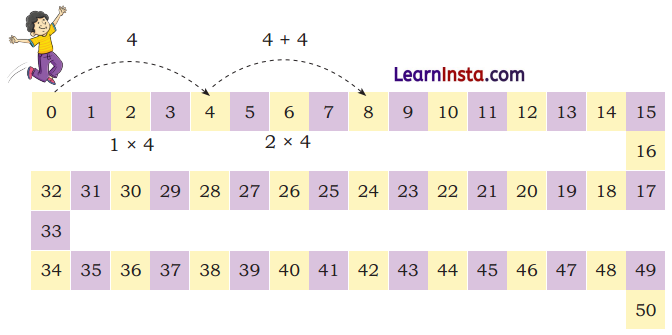
Answer:

Question 7.

Gopal is doing skip jumping of __________ steps.
After 27 he will jump on __________
Answer:

Gopal is doing skip jumping of 9 steps.
After 27 he will jump on 36, 45.
Question 8.
What times table can you construct from Gopal’s jumps? Make it in your notebook.
Answer:
1 × 9 = 9
2 × 9 = 18
3 × 9 = 27
4 × 9 = 36
5 × 9 = 45
6 × 9 = 54
7 × 9 = 63
8 × 6 = 72
9 × 9 = 81
10 × 9 = 90
![]()
Question 9.
Dhara also skip jumps. Gopal notes down the jumps but he misses the first few numbers.

By what numbers was Dhara skip jumping? Construct the times table of this number in your notebook.
Answer:
8, 16, 24, 32, 40, 48, 56
1 × 8 = 8
2 × 8 = 16
3 × 8 = 24
4 × 8 = 32
5 × 8 = 40
6 × 9 = 48
7 × 8 = 56
8 × 8 = 64
9 × 8 = 72
10 × 8 = 80
Fun Way of Writing Tables (NCERT Textbook Page 98)
Question 1.
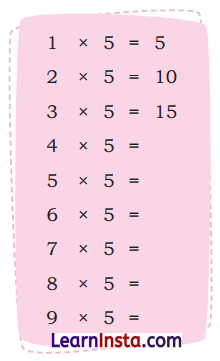
Answer:
1 × 5 = 5
2 × 5 = 10
3 × 5 = 15
4 × 5 = 20
5 × 5 = 25
6 × 5 = 30
7 × 5 = 35
8 × 5 = 40
9 × 5 = 45
Seeing Patterns in Multiplication Tables (NCERT Textbook Page 99)
Question 1.
Give 3 examples of numbers that when taken 5 times gives an answer ending with
(i) 0 ______ ______ ______
(ii) 5 ______ ______ ______
Answer:
(i) 0 10 20 30
(ii) 5 15 25 35
Question 2.
Without finding the answer, can you tell the last digits of 18 × 5, 23 × 5, 32 × 5, 50 × 5.
Answer:
0, 5, 0, 0
Let us Do (NCERT Textbook Page 100)
Question 1.
Draw pictures for each of the following problems in your notebook. Use counting, number line jumps or any other method to solve the problems.
(a) There are 5 jars with 4 cookies in each jar. How many cookies are there?
Answer:
Number of cookies in 1 jar = 4
Therefore, number of cookies in 5 jars = 5 × 4 = 20 cookies
or 4 + 4 + 4 + 4 + 4 = 5 times 4 = 5 × 4 = 20 cookies.
or By step jumping of 4 steps 5 times

(b) An idli vessel contains 6 idli plates. In each plate we can make 4 idlis. How many idlis can be cooked in one go?
Answer:
Number of idli plates contained by an idli vessel = 6 plates
Number of idli in an idli plate = 4
Therefore, number of idlis can be cooked in an idli vessel in one go = 6 × 4 = 24 idlis.
(c) 30 cookies are to be distributed among 5 children equally. How many cookies will each child get?
Answer:
Total number of cookies = 30
Total number of children = 5
Number of cookies each child will get

Therefore, number of cookies each child will get = 6
∴ Each child will get 6 cookies.
![]()
(d) Roro starts from 0 and takes 6 jumps to reach 18. All his jumps are of the same size. What is the size of Roro’s jump?
Answer:

Size of Roro’s jump = 3 steps
(e) Toto does not take jumps of the same size and still reaches 18 in 6 jumps. How did Toto jump?
Answer:

(Answer may vary)
(f) Suma saves ₹ 8 every day. After how many days will she have ₹ 56?
Answer:
Daily saving of Suma = ₹ 8
Number of days when Suma saves = ₹ 56
56 ÷ 8 = 7
Thus, in 7 days (1 week) Suma saves = ₹ 56
(g) Mary has 63 sea shells. She gives 7 sea shells to each of her 5 friends. How many does she have left?
Answer:
Total number of sea shells = 63
Total number of friends = 5
Number of sea shells each friend will get = 7
∴ Total number of sea shells distributed among her 5 friends = 5 × 7 = 35
Number of sea shells left = 63 – 35 = 28
Question 2.
Solve the following problems. Try constructing a word problem.
(a) 4 × 9
Answer:
4 × 9 = 36
Suman saw 9 cows in the shed.
How many legs of cows are there in the shed? (Answer may vary)
(b) 32 ÷ 8
Answer:
32 ÷ 8 = 4
Ajit has 32 oranges. He wants to distribute the oranges among his friends.
How many oranges each of his friends will get? (Answer may vary)
(c) 6 × 7
Answer:
6 × 7 = 42
Rashi reads 6 pages daily of her favourite novel.
How many pages will she read in a week? (Answer may vary)
(d) 45 ÷ 5
Answer:
45 ÷ 5 = 9
Suman saw 45 wheels in her farm of the bullock carts.
How many bullock carts are there in her farm? (Answer may vary)
Try these (NCERT Textbook Page 101)
Question 1.
30 × 5 = __________
(Hint: You can find this by counting the spokes in 30 wheels.)
First 10 wheels will have __________ spokes
Next 10 wheels will have __________ spokes
Next 10 wheels will have __________ spokes
Total = __________ spokes
30 × 5 = __________ spokes
Answer:
30 × 5 = 150
(Hint: You can find this by counting the spokes in 30 wheels.)
First 10 wheels will have 10 × 5 = 50 spokes
Next 10 wheels will have 10 × 5 = 50 spokes
Next 10 wheels will have 10 × 5 = 50 spokes
Total = 150 spokes
30 × 5 = 150 spokes
![]()
Question 2.
Complete the following.
40 × 5 = __________
50 × 5 = __________
60 × 5 = __________
70 × 5 = __________
80 × 5 = __________
90 × 5 = __________
100 × 5 = __________
Answer:
40 × 5 = 200
50 × 5 = 250
60 × 5 = 300
70 × 5 = 350
80 × 5 = 400
90 × 5 = 450
100 × 5 = 500
Question 3.
Dhara collected 45 spokes. How many wheels can she make?
Answer:
5 + 5 + 5 + 5 + 5 + 5 + 5 + 5 + 5 = 9 times 5 = 9 × 5 = 45
Thus, she can make 9 wheels.
Question 4.
Does Dhara have enough spokes to make 10 wheels?
Answer:
No, she does not have enough spokes to make 10 wheels.
As number of spokes in 10 wheels = 10 × 5 = 50 but she has only 45 spokes.
Question 5.
How many wheels can you make with 60 spokes?
Answer:
Number of spokes used to make 1 wheel = 5
Number of wheels using 60 spokes = 60 ÷ 5 = 12 wheels
Thus, 12 wheels can be made with 60 spokes.
Let us Do (NCERT Textbook Page 102-103)
Question 1.
A spider has 8 legs.

5 spiders will have __________ legs.
10 spiders will have __________ legs.
15 spiders will have __________ legs.
Answer:
5 spiders will have 5 × 8 = 40 legs.
10 spiders will have 10 × 8 = 80 legs.
15 spiders will have 15 × 8 = 120 legs.
Question 2.
How many legs will 23 spiders have?
Answer:
23 spiders will have 23 × 8 = 184 legs.
![]()
Question 3.
A group of spiders have 32 legs. How many spiders are there in the group?
Answer:
Number of legs of a spider = 8
Number of spiders in the group:

Therefore, number of spiders in the group is 4.
Question 4.
Here is a 3-wheeled auto rickshaw.

How many wheels are there in
(a) 18 auto rickshaws?
(b) 34 auto rickshaws?
Answer:
(a) Number of wheels in 18 auto rickshaws = 18 × 3 = 54
(b) Number of wheels in 34 auto rickshaws = 34 × 3 = 102 wheels
Question 5.
Auto rickshaws in a garage have a total of 36 wheels. How many auto rickshaws are there in the garage?
Answer:
Number of wheels in an auto rickshaws = 3
Number of wheels in auto rickshaws in a garage = 36
∴ Number of auto rickshaws in the garage = 36 – 3 = 33, 33 – 3 = 30, 30 – 3 = 27, 27 – 3 = 24, 24 – 3 = 21, 21 – 3 = 18, 18 – 3 = 15, 15 – 3 = 12, 12 – 3 = 9, 9 – 3 = 6, 6 – 3 = 3, 3 – 3 = 0
Thus, there are 12 auto rickshaws in the garage.
Question 6.
There is a line of 55 ants (one ant has 6 legs). What is the total number of legs in the line?
Answer:
Number of legs of an ant = 6
Total number of legs of 55 ant in the line = 55 × 6 = 330 legs
Question 7.
Micky, the mouse, can see 48 legs of cows in the shed. How many cows are there in the shed?
Answer:
Number of legs of a cow = 4
Number of legs of cows in the shed = 48
Number of cows in the shed = 48 ÷ 4 = 12 cows
Question 8.
Karry, the crow, can see 24 horns of cows in the shed. What is the total number of legs in the shed?
Answer:
Number of horns of a cow = 2
Total number of horns in the shed = 24
Total number of cows in the shed = 24 ÷ 2 = 12 cows
Number of legs of a cow = 4
Therefore, number of legs of 12 cows = 12 × 4 = 48 legs.
Let us Do (NCERT Textbook Pages 103-104)
Question 1.
A frog is at 0. It takes jumps of only 7. What would be the largest number that the frog will reach before crossing 50?

Answer:

7 × 1 = 7, 7 × 2 = 14, 7 × 3 = 21, 7 × 4 = 28, 7 × 5 = 35, 7 × 6 = 42, 7 × 7 = 49
Thus, the largest number that the frog will reach before crossing 50 is 49.
![]()
Question 2.
A frog wants to jump backwards from 50. It continues to take jumps of 7. What is the number after which it is not possible for the frog to make a jump of 7?

Answer:

50 – 7 = 43, 43 – 7 = 36, 36 – 7 = 29, 29 – 7 = 22, 22 – 7 = 15, 15 – 7 = 8, 8 – 7 = 1
Thus, the number, after which it is not possible for the frog to make a jump of 7 is 1.
Question 3.
What numbers should the frog start from to reach 0, taking jumps of 7 each time? What do you observe?

Answer:

49 – 7 = 42, 42 – 7 = 35, 35 – 7 = 28, 28 – 7 = 21, 21 – 7 = 14, 14 – 7 = 7, 7 – 7 = 0
Thus, the frog should start from 49 to reach 0, taking jumps of 7 each time.
Puri Beach (NCERT Textbook Page 104)
Question 1.
One wall-hanging costs ₹ 42. How much do two wall hangings cost?

Two wall hangings cost ₹ 42 + ₹ 42 = 2 × ₹ 42
The cost of the two wall hangings: __________
Answer:
Two wall hangings cost ₹ 42 + ₹ 42 = 2 × ₹ 42
The cost of the two wall hangings: ₹ 84
Question 2.
One Rabdi cup costs ₹ 75. Preeti buys 5 cups of Rabdi. She has her mother’s purse which has only ₹ 100 notes.

How many ₹ 100 notes should she give the shopkeeper? How much will the shopkeeper then return to Preeti? What is the total cost of 5 cups of Rabdi?
Answer:
Cost of 1 cup of Rabdi = ₹ 75
Cost of 5 cups of Rabdi = ₹ 75 × 5 = ₹ 375
Therefore, she gives 4 notes of ₹ 100 to the shopkeeper.
The shopkeeper will return = ₹ 400 – ₹ 375 = ₹ 25
Sea Shells (NCERT Textbook Pages 104-105)
Dhruv lives near the sea. He thought of making a necklace for each of his three friends. He looked for sea-shells the whole day. He collected 112 sea-shells by the evening. Now, he has many different coloured and shiny shells.

He took 28 shells for one necklace.
112 – 28 = 84
Now he was left with 84 shells. Again he took 28 more shells for the second necklace.
![]()
Question 1.
How many shells are left now?
Then he took shells for the third necklace.
So he was left with __________ shells.
Are the shells enough for making necklaces for all his friends? __________
How many necklaces can Dhruv make from 112 shells? __________
Answer:
Number of shells used in making 1 necklace = 28
Number of shells left after one necklace = 84
Number of shells left after second necklace = 84 – 28 = 56.
Then he took shells for the third necklace.
So he was left with 56 – 28 = 28 shells.
Are the shells enough for making necklaces for all his friends? Yes.
How many necklaces can Dhruv make from 112 shells? 112 ÷ 28 = 4
Thus, Dhruv can make 4 necklaces from 112 shells.
Try these (NCERT Textbook Page 105)
Question 1.
Kannu makes a necklace of 17 sea-shells. How many such necklaces can be made using 100 sea-shells?
Answer:
Number of necklaces using 100 sea shells.

Thus, 5 necklaces can be made using 100 sea-shells and 15 sea-shells are left.
Question 2.
While searching for sea-shells, Dhruv also finds 127 shiny pebbles. He distributes them equally to his 3 friends. How many will each get?
Answer:
Number of pebbles each of the three friends gets:
127 – 42 = 85, 85 – 42 = 43, 43 – 42 = 1
Thus, each friend will get 42 pebbles and 1 pebble is left with him.
Question 3.
Preeti has a ₹ 500 note and wants to exchange it for lower denomination notes. How many notes will she get if she wants-
(i) All 50 rupees notes?
(ii) All 20 rupees notes?
(iii) All 10 rupees notes?
Answer:
(i) Number of notes of ₹ 50 = 500 ÷ 50 = 10 notes
(ii) Number of notes of ₹ 20 = 500 ÷ 20 = 25 notes
(iii) Number of notes of ₹ 10 = 500 ÷ 10 = 50 notes
![]()
Let us Explore (NCERT Textbook Page 106)
There are ten number cards from 1–10. There are five sealed envelopes. Each has two cards On the top of each envelope the multiplication of the numbers contained in it is written. The 5th envelope contains the cards 5 and 9. The number 5 × 9 = 45 is written on the envelope.

Identify the number cards inside each of the envelopes.
Answer:
